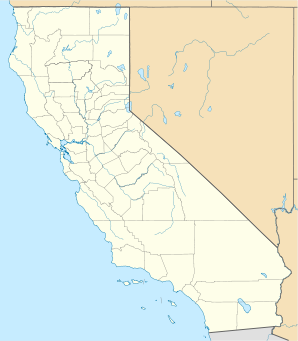| San Andreas | ||
|---|---|---|
 San Andreas, (Kalifornien) Hauptstraße | ||
| Lage in Kalifornien | ||
|
| ||
| Basisdaten | ||
| Staat: | Vereinigte Staaten | |
| Bundesstaat: | Kalifornien | |
| County: | Calaveras County | |
| Koordinaten: | 38° 12′ N, 120° 41′ W | |
| Zeitzone: | Pacific (UTC−8/−7) | |
| Einwohner: | 2.615 (Stand: 2000) | |
| Höhe: | 310 m | |
| Postleitzahlen: | 95249-95250 | |
| Vorwahl: | +1 209 | |
 „The old Calaveras County Courthouse“, das alte Gerichtsgebäude des Calaveras County erbaut 1867 | ||
San Andreas ist eine kleine Stadt im Calaveras County, Kalifornien, dessen Verwaltungssitz (“County Seat”) sie ist. San Andreas ist ein sogenanntes „gemeindefreies Gebiet“(“unincorporated area”) und ein („census-designated place“) Bei der letzten Erhebung im Jahre 2000 wurden 2,615 Einwohner gezählt. Wie die meisten Orte der Region wurde die Stadt während des amerikanischen Goldrausches gegründet. Die Stadt liegt an der California State Route 49 und ist als California Historical Landmark Nummer 252 gelistet.
Geschichte Bearbeiten
Um 1848 wurde der Ort von mexikanischen Goldgräbern besiedelt und nach dem katholischen Heiligen St. Andreas benannt. Zunächst war die heutige Stadt nur ein Goldgräbercamp. Die Entdeckung einer reichen unterirdischen Goldader belebte das Camp und es wuchs schnell zu einer Stadt heran. Die Goldausbeute war ertragreich genug, um die Stadt nach zwei verheerenden Bränden 1858 und 1863 komplett weider aufzubauen.
Die Goldfunde trugen massgeblich zum Erfolg der Unions-Truppen während des Amerikanischen Bürgerkrieges bei. 1854 wurde eine Poststation gegründet und 1866 wurde der Ort Verwaltungssitz der Kreises („County Seat“)
Today San Andreas has a modern feel due to expanding population and highway realignments. A few Gold Rush buildings, however, remain on Main Street: the stone Fricot Building, an I.O.O.F. hall and an old courthouse, which also houses part of the Calaveras County Museum and Archives. The museum is open daily except for major holidays.
The California Caverns, discovered by a prospector in 1849 (or 1850 according to some sources), are located 12 miles east of San Andreas off Mountain Ranch Road. The caves were opened to the public in 1850. Cave explorers from the 1850s left their signatures on the walls. Guided tours of the extensive caverns are offered daily. Families will enjoy the "Trail of Lights" tour, lasting about 80 minutes, while the more adventurous might want to try the "Wild Cave" expedition.
A winding back road takes visitors on an alternate route from Highway 49 between Altaville and San Andreas. Follow Dogtown Road, which turns into Calaveritas Road, through the sites of such towns as Dogtown, Calaveritas, Scratch Gulch and Brandy Flat. All the towns are gone except for Calaveritas, where only a few buildings remain.
History of gold mining through the thirty's. History dates back to 1864.Submitted by: Ace C. Young
San Andreas was founded in 1849, by mexican miners who 1st discovered gold in the rich gravels. American miners crowded them out in 1850, then thousands of Chinese moved in and reworked the tailings considered useless by others. San Andreas is probably noted most for being the place where the infamous "Gentleman Bandit", Black Bart was tried, and sentenced to 6 years at San Quentin for a series of stagecoach robberies. Bart was actually Charles E. Boles from Illinois, but after a number of very successful robberies, he changed his name to Charles Bolton, and moved to San Francisco. During a holdup near Copperopolis, Bart was wounded and dropped a handkerchief with a laundry mark "FX07". The handkerchief was traced to San Francisco, where police made one of the most surprising arrests in its history, for Charles Bolton was one of San Franciso's leading citizens, and had close connections in the police department. New highway alignments, and other demands of modern civilization, have stripped San Andreas of most of its mining camp character, leaving only a few of the original gold rush era buildings. The remaining examples of early architecture include the dressed-stone Fricot building, now housing the county library; a two-story I.O.O.F. Hall; and the courthouse, which is now home to the Chamber of Commerce, and a museum with a good collection of local historical items. Behind the courthouse is the old jail with a cell marked "Black Bart slept here". Just west of town is the historic Pioneer Cemetery, dating back at least to 1851. Most of the graves are unmarked, but a few headstones have some intriguing in-scriptions. Many of the graves here were moved from Lancha Plana, Camanche, and Poverty Bar, when Camanche Lake inundated those towns. Submitted by Bob Stelow.
Founded in 1848 by Mexican prospectors, it was one of the earliest to suffer from the racial clashes that rocked the Mother Lode. When the riches of San Andreas became known, American miners poured in and drove out many of the Mexicans. It is here so the story goes that Joaquin Murieta got his start and became one of the most famous Mexican bandits of his time. Swearing vengeance for the hanging of his brother for a crime he did not commit, Joaquin formed a band of cutthroats and preyed on American settlements up and down the Mother Lode. A good starting point for an historical tour is the local museum. Submitted by Henry Chenoweth
Trivia Bearbeiten
The perhaps fictitious bandit Joaquin Murieta is said to have frequented the region. And the poetic and always polite highwayman known as Black Bart jailed and tried in the courthouse that is now a museum before he was taken to San Quentin Prison.
Weblinks Bearbeiten
References Bearbeiten
- Sukuru/San Andreas (Kalifornien). In: Geographic Names Information System. United States Geological Survey, United States Department of the Interior (englisch).
[[Category:Census-designated places in Calaveras County, California]] [[Category:California Historical Landmarks]] [[Category:County seats in California]] [[Category:Populated places established in 1848]] [[ca:San Andreas (Califòrnia)]] [[es:San Andreas (California)]] [[fr:San Andreas (Californie)]] [[pam:San Andreas, California]] [[nl:San Andreas (Californië)]] [[ja:サンアンドレアス (カリフォルニア州)]] [[ru:Сан-Андреас (Калифорния)]] [[vo:San Andreas]]
